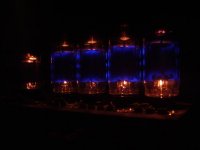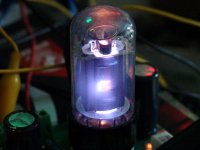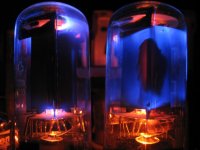What makes a tube glow blue guys?
is there a particular kind of tube that glows more than others?
Reason i ask is my tubelab sse has chinese 6l6gc tubes that glow with a little blue just after startup but fades after a few seconds but some images i see on here are just divine!
Its purely an asthetic thing but it would be nice to see the blue all the time😱
is there a particular kind of tube that glows more than others?
Reason i ask is my tubelab sse has chinese 6l6gc tubes that glow with a little blue just after startup but fades after a few seconds but some images i see on here are just divine!
Its purely an asthetic thing but it would be nice to see the blue all the time😱
My EH kt88 have a nice blue glow on the glass.
Where is the blue glow coming from. Some is asthetic andother times can be spectacular (when it fries)
Where is the blue glow coming from. Some is asthetic andother times can be spectacular (when it fries)
Unless you're talking about mercury vapor rectifiers -
or voltage regulator tubes -

the blue glow you refer to is caused by electrons that are accelerated past the tube structure and hits the glass envelope, where it excites impurities in the glass.
I'm running with a small sweep tube power amp using a 6LU8 tube. One is a Westinghouse brand and does not exhibit the blue glow. The other is an RCA branded tube and this one does glow blue around the pentode section. Increasing the anode voltage increases the amount of blue light emission as the electrons flowing in the tube are accelerated to higher velocities due to the higher anode voltage. This causes more of them to leave the tube structure and hit the glass... The higher anode voltage is not a desirable operating point from a distortion stand point, though.
I'm guessing the reason your tubes glow blue on start-up and then fade is because it takes a while for the bias voltage to stabilize.
If you really, really want blue light, you could pull the tacky, el-cheapo Chinese eBay amp trick and add a blue LED below the tube socket... Or you could buy a bunch of 6L6'es of different brands and see if you can find any that glow blue in your amp.
~Tom
An externally hosted image should be here but it was not working when we last tested it.
or voltage regulator tubes -

the blue glow you refer to is caused by electrons that are accelerated past the tube structure and hits the glass envelope, where it excites impurities in the glass.
I'm running with a small sweep tube power amp using a 6LU8 tube. One is a Westinghouse brand and does not exhibit the blue glow. The other is an RCA branded tube and this one does glow blue around the pentode section. Increasing the anode voltage increases the amount of blue light emission as the electrons flowing in the tube are accelerated to higher velocities due to the higher anode voltage. This causes more of them to leave the tube structure and hit the glass... The higher anode voltage is not a desirable operating point from a distortion stand point, though.
I'm guessing the reason your tubes glow blue on start-up and then fade is because it takes a while for the bias voltage to stabilize.
If you really, really want blue light, you could pull the tacky, el-cheapo Chinese eBay amp trick and add a blue LED below the tube socket... Or you could buy a bunch of 6L6'es of different brands and see if you can find any that glow blue in your amp.
~Tom
6P1P is notorious for blue glow along the screen rods inside the tube.
Then there is the occasional blue glow that is not good:
Then there is the occasional blue glow that is not good:
An externally hosted image should be here but it was not working when we last tested it.
The 5B/254M produces a nice glow around the glass. See here:
http://www.diyaudio.com/forums/tubes-valves/161255-cv428-5b254m-useful-3.html
Just for fun I hooked one up on the bench this morning and even at 200v/35mA plate it produced a faint blue ring around the glass extending about 3/4" up from the base of the plate structure.
Gary
http://www.diyaudio.com/forums/tubes-valves/161255-cv428-5b254m-useful-3.html
Just for fun I hooked one up on the bench this morning and even at 200v/35mA plate it produced a faint blue ring around the glass extending about 3/4" up from the base of the plate structure.
Gary
My EH kt88 have a nice blue glow on the glass.
Mine did when I got them, but now 2 years later they still rock, but don't glow much.
SED KT88s have a very pleasant blue glow on the glass. Not as apparent in the pic, but strong in person:
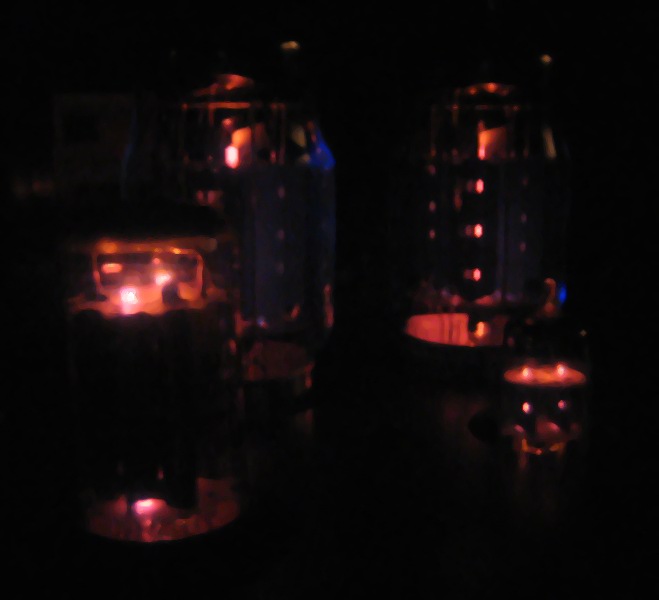
Their EL34s also glow, especially near the screens.

Their EL34s also glow, especially near the screens.
There are three common types of blue glow I believe,
One comes from electrons hitting the glass and causing it to fluoresce, if the glass contains the right elements (presumably harmless?) That's what you see in SpreadSpectrum's photo.
The second comes from a very poor vacuum and the residual gas ionizes like a voltage regulator tube (bad valve!), which is The Gimp's photo I think.
The third is the blue glow you nearly always get between the screen grid and suppressor in pentodes, due to ionized gas being re-neutralized by the slow electrons around the suppressor, also harmless. You can see this is Wavebourn's photo. Sometimes this can reflect off the glass and be mistaken for the first type of glow, which I think is the case in Rznize's photo.
One comes from electrons hitting the glass and causing it to fluoresce, if the glass contains the right elements (presumably harmless?) That's what you see in SpreadSpectrum's photo.
The second comes from a very poor vacuum and the residual gas ionizes like a voltage regulator tube (bad valve!), which is The Gimp's photo I think.
The third is the blue glow you nearly always get between the screen grid and suppressor in pentodes, due to ionized gas being re-neutralized by the slow electrons around the suppressor, also harmless. You can see this is Wavebourn's photo. Sometimes this can reflect off the glass and be mistaken for the first type of glow, which I think is the case in Rznize's photo.
Last edited:
Dunno what exactly it's from, I'd say fluorescence of the glass surface. It's not associated with outright ionization, because nothing is kicked out from the area (the plate in that area doesn't get sprayed with vaporized glass), nor is it associated with penetrating radiation (some UV probably results, internally, but is absorbed by the glass).
The peculiar thing is, glass has long been known to fluoresce due to electron bombardment, but with a pale green color, associated with x-ray emission! This takes voltages over 10kV and is not a hazard for most vacuum tubes. Maybe glass fluoresces a different color at lower electron energies.
Ya know, I need to bring a 6L6 to a spectrometer some day and measure this glow. If it's peaky, it's probably fluorescence; if it's broadband, it could still be fluorescent, but a rapid decay fluorescence (short time = high uncertainty in wavelength), or a filtered spectrum (like shining white light through cobalt glass). Or it might have another physical mechanism altogether (e.g. Cerenkov radiation -- note that Cerenkov specifically requires way higher energies than x-rays alone so is definitely ruled out in this case).
Tim
The peculiar thing is, glass has long been known to fluoresce due to electron bombardment, but with a pale green color, associated with x-ray emission! This takes voltages over 10kV and is not a hazard for most vacuum tubes. Maybe glass fluoresces a different color at lower electron energies.
Ya know, I need to bring a 6L6 to a spectrometer some day and measure this glow. If it's peaky, it's probably fluorescence; if it's broadband, it could still be fluorescent, but a rapid decay fluorescence (short time = high uncertainty in wavelength), or a filtered spectrum (like shining white light through cobalt glass). Or it might have another physical mechanism altogether (e.g. Cerenkov radiation -- note that Cerenkov specifically requires way higher energies than x-rays alone so is definitely ruled out in this case).
Tim
It is pretty when it happens... but tough to capture in photos.
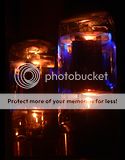


http://i69.photobucket.com/albums/i43/Ty_Bower/Tubes/Blue6L6.jpg
http://i69.photobucket.com/albums/i43/Ty_Bower/Tubes/P1100546.jpg
http://i69.photobucket.com/albums/i43/Ty_Bower/GetSetGo/6B4G_blue.jpg



http://i69.photobucket.com/albums/i43/Ty_Bower/Tubes/Blue6L6.jpg
http://i69.photobucket.com/albums/i43/Ty_Bower/Tubes/P1100546.jpg
http://i69.photobucket.com/albums/i43/Ty_Bower/GetSetGo/6B4G_blue.jpg
I know that some Russian 6P3S tubes have a glass that glows blue when bombarded by electrons.
I have some Reflector 6P3S that have a nice blue glow. Newtube, maybe you could try a couple in your Simple SE, they will sub for 6L6, which has lower power dissipation than 6L6GC. They don't cost much.
Ian.
Dunno what exactly it's from, I'd say fluorescence of the glass surface.
Popular speculation says it's flourescence due to traces of cobalt in the glass. That may explain why some tubes glow easilly, but some won't glow even if you crank them. The glow does seem more voltage dependent than dissipation or current dependent. My recent experiments with sweep tubes in the 550 to 600 volt range would provoke glow in most tubes, even some rather crusty old ones.
It's not blue, but tubes with thoriated tungsten cathodes are bright enough to be lightbulbs 🙂
I've wanted to try MV rectifiers, but the downsides outweigh having that cool glow...at least for now...
An externally hosted image should be here but it was not working when we last tested it.
I've wanted to try MV rectifiers, but the downsides outweigh having that cool glow...at least for now...
Mine did when I got them, but now 2 years later they still rock, but don't glow much.
I've had a couple pair of 300b tubes which glowed for the first few months, but don't anymore. The tubes are still in perfect shape. Why would they stop glowing? Think somethings changing w/ the emission of the electrons, or with the fluorescing impurity in the glass?
George posted once some spectacular blue when he was torturing some 6V6GTYs I think. So nice that I kept some in my HD. TubelabTM.😀 I have also found a 6P3 kinda blue pic, don't remember if it was from George again.
Attachments
- Status
- Not open for further replies.
- Home
- Amplifiers
- Tubes / Valves
- blue glow, how?

